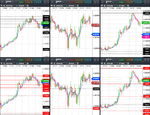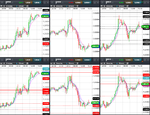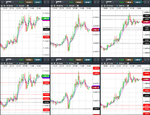======================================================================
Thank you for your observations.
Following your assumptions....
1.) Everyone is trying to predict the markets. In John Murphy's book on technical analysis there are many ways to draw lines at different timescales carrying out many different types of analysis...Gann, Fibonacci, Wedge, Bollinger, RSI, Triangles.....and on. So are you saying that everyone's effort to predict the markets is futile?
This is incorrect. Retail traders that don't make money are trying to predict the markets. That is not 'everyone'. All of the stuff you mentioned - Gann, Fibonacci, Bollinger, RSI represent failed attempts at trying to predict the market.
Think about this - which is statistically more likely at any point in time...
A) The markets will continue to do what they are currently doing
B) The markets will suddenly change and do something else
You are attempting to make money from B. Yet, you can make money from A. And we both know that A is more likely at any point in time.
The reason you are looking at B so hard is that you have been fished into the retail myth that trading is about finding a turning point in the markets.
2.) Many of the technical trading analysis methods are trying to predict the turning point in the market. These reversals can be used to start and end trades. Are you saying that trying to predict reversals is futile?
Technical analysis is the domain of sell-side finance. It exists to entice people to trade. So for example - when you see a technical analyst on TV explaining his view of the market - he is not a trader. He is someone employed to generate interest in the market.
Look up the difference between buy side and sell side finance. Then you will come closer to understanding the reason the information you are using exists.
3.) Many trading indicators are mathematical in nature. Such as RSI, Gann and MAs. There is lots of maths out there. Are you saying that using maths is futile?
Indicators do not work. Period. They have no predictive value. If one did - someone would have proven that it did. Did you ever wonder why there were so many of them in your average trading platform?
To be at the point you are at - you must have tested indicators and found them lacking already. After all why develop anything if you can just use a couple of Bollingers and a MACD?
Your conclusion - they just weren't the 'right' indicators - so you try to code your own up.
If 95% of traders fail and almost all the information you find about trading is technical analysis - use math to figure out the chance that you are really looking in the right place.
The VRM generates 24 weekly levels and 24 daily levels. There are large gaps. Surely it is worth the time to look for the large gaps and make that trade. You may have noticed that the sentiment levels labelled Sn are often bunched together. I call them the asteroid belt. When the market is within these levels then there will be lots of collisions with these levels as the market at different time scales fight with each other. Surely that information is useful.
No information is useful for what you are trying to do. You will always find yourself selling a market that is moving up and buying a market that is moving down.
Every night I present a set of levels where reversals could occur. If the maths is correct then this eliminates a lot of the real number system where reversals do not occur. And at 5 pm New York time I present the actual price action overlapping the VRM levels. The proof of the pudding is in the eating. To test the maths look at the results.
The only thing of importance in trading is....
- Why would traders behave a certain way after you enter?
Something you have not explained. You have no 'why' - only math.
Finally your analogy of a crowd in a shopping mall. Interestingly mathematicians have tried to model that as well. See
http://reu.dimacs.rutgers.edu/2015/DIMACS-REU-Piccoli-2015.pdf
I would have enjoyed being at that presentation
You see - this is where common sense comes into it. The answer to the question "how do you know where they will all be in 15 minutes is simple" - you set off the fire alarm. They would all be outside.
What you need to be doing is finding the markets fire alarms.
There 'book smarts' and 'street smarts. The best traders have more of the latter than the former.









